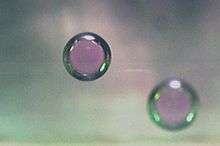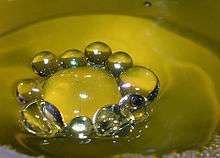Antibubble
An antibubble is a droplet of liquid surrounded by a thin film of gas,[1] as opposed to a gas bubble, which is a sphere of gas surrounded by a liquid. Antibubbles are formed when liquid drops or flows turbulently into the same or another liquid. They can either skim across the surface of a liquid such as water, in which case they are also called water globules, or they can be completely submerged into the liquid to which they are directed.


Background
Antibubbles are a common but widely unrecognized phenomenon, in part because of their resemblance to air bubbles, and in part because of their typically transient, or short-lived, nature. With certain (soapy) solutions, they can be made to last much longer.
Antibubbles can be created by allowing a tap to drip into a container of water to which a drop or two of soap has been added. Being inherently unstable, they are difficult to form. The soap reduces the water's surface tension and allows the skin of air surrounding the droplet to remain in place for more than just a fraction of a second.
Just as soap bubbles, with air inside and air outside, have negative buoyancy and tend to sink towards the ground, so antibubbles, with water inside and air outside have positive buoyancy and tend to rise towards the water surface. But again, just as soap bubbles can be filled with a lighter gas to give them positive buoyancy, so antibubbles can be filled with a heavier liquid to give them negative buoyancy. Using a drinking straw to drop droplets of sugar solution onto soapy water will produce antibubbles that sink.
Antibubbles usually pop when they touch the bottom or the side of the vessel containing the liquid. This can be prevented by tipping a few teaspoons of sugar into the soapy water and giving it some time to dissolve (but without stirring it). This will produce a denser layer of sugary water at the bottom of the container. Antibubbles made from sugar solution will then sink through the water and rest on top of the denser layer at the bottom. Antibubbles made this way can last for several minutes.
The layers of an antibubble are water, which it is submerged in, air, and the water trapped in the air.
Differences between air bubbles and antibubbles
The behavior of antibubbles differs from that of air bubbles in three primary ways, and provides a ready means of identification:
- Antibubbles are held in place by surface tension, and move rapidly across the surface of the water. They can also be seen to ricochet off other objects in the water (such as air bubbles) and off the sides of a container in a manner similar to that of billiard balls.
- Under ordinary circumstances, antibubbles are short-lived. An air bubble with a soap skin may last several minutes. Antibubbles often have lifetimes of a few seconds or less; however, if the electrical potential between the inner and outer fluid is equalized, antibubbles can last as long as, or longer than, air bubbles. Antibubbles with a lifetime of at least tens of hours can be produced by adsorbing colloidal particles at the air-water interfaces of the antibubble.
- Antibubbles refract light in a different manner than air bubbles. Because they are water droplets, light entering them is refracted back toward its source in the same manner as rainbows are produced. Because of this refraction, antibubbles have a bright appearance.
Potential uses for antibubbles
If antibubbles can be stabilized they can be used to form a long lasting froth — antifoam. Possible uses for antifoam are as a lubricant or using the thin passageways permeating antifoam as a filter for air or other gasses.
Antibubbles themselves could be used for chemical processes such as removing pollutants from a smokestack. Replacing the air in antibubble shells with another liquid could be used for a drug delivery system by creating a shell of liquid-polymer around a drug. Hardening the polymer with ultraviolet light would create a drug filled capsule.
Lifetime
The lifetime of surface antibubbles can be prolonged indefinitely by making the water under them vibrate.[2][3] These are called "walking bubbles" and are used as a model of quantum mechanical behavior.[4]
References
- Morioka, Shigeki; Wijngaarden, Leen van (2012-12-06). IUTAM Symposium on Waves in Liquid/Gas and Liquid/Vapour Two-Phase Systems: Proceedings of the IUTAM Symposium held in Kyoto, Japan, 9–13 May 1994. Springer Science & Business Media. ISBN 9789401100571.
- Cabrera-Garcia, Pablo; Zenit, Roberto (2012). "Droplets bouncing over a vibrating fluid layer". arXiv:1210.3538 [physics.flu-dyn].
- Drops on Drops on Drops
- Hydrodynamic quantum analogs
- Dorbolo S, Caps H, Vandewalle N (2003). "Fluid instabilities in the birth and death of antibubbles". New Journal of Physics. 5 (Dec. 22): 161. Bibcode:2003NJPh....5..161D. doi:10.1088/1367-2630/5/1/161.
- Het Panhuis M, Hutzler S, Weaire D, Phelan R (1998). "New variations on the soap film experiments of Plateau I: Experiments under forced drainage". Philosophical Magazine B. 78 (July 1): 1–12. Bibcode:1998PMagB..78....1P. doi:10.1080/014186398258320.
- Kim PG, Stone HA (2008). "Dynamics of the formation of antibubbles". Europhysics Letters. 83 (5): 54001. Bibcode:2008EL.....8354001K. doi:10.1209/0295-5075/83/54001.
- Postema M, de Jong N, Schmitz G, van Wamel A (2005). "Creating antibubbles with ultrasound". Proc IEEE Ultrason Symp: 977–980.
- Tufaile A, Sartotelli JC (2002). "Bubble and spherical air shell formation dynamics". Physical Review E. 66 (November): 056204. Bibcode:2002PhRvE..66e6204T. doi:10.1103/PhysRevE.66.056204. PMID 12513583.
- Weiss P (May 15, 2004). "The rise of antibubbles". Science News. 165 (20): 311–312. doi:10.2307/4015222. JSTOR 4015222.
- Poortinga A (January 20, 2011). "Long-lived antibubbles: stable antibubbles through Pickering stabilization". Langmuir. 27 (6): 2138–2141. doi:10.1021/la1048419. PMID 21250742.
- Stong CL (April 1974). "The amateur scientist: Curious bubbles in which a gas encloses a liquid instead of the other way around". Scientific American. 230 (4): 116–120. doi:10.1038/scientificamerican0474-116.